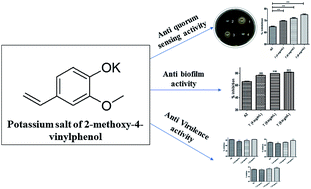Potassium 2-methoxy-4-vinylphenolate: a novel hit exhibiting quorum-sensing inhibition in Pseudomonas aeruginosa via LasIR/RhlIR circuitry†
Abstract
The emergence of multidrug-resistant (MDR) bacterial strains in the last decade is astonishingly alarming. Many of the widely used antibiotics have failed to exhibit clinical efficacy against such strains. Eventually we will exhaust all the resources in our antibiotic armamentarium. As a need of the hour, novel strategies are desperately required not only to curb, but also to reverse, the development of resistance in these pathogens, thereby maintaining their sensitivity towards current antibiotics. Intervention of bacterial virulence, rather than killing them, by inhibiting specific pathways/targets has emerged as a novel approach to tackle the drug resistance problem. The bacterial virulence is regulated via quorum-sensing, a cell–cell communication process precisely controlled by autoinducer molecules such as acyl homoserine lactone (AHL). The present study aimed at identifying promising quorum-sensing inhibitors in Pseudomonas aeruginosa, an opportunistic human pathogen especially associated with nosocomial infections, yielding four potential hits. Out of these, potassium 2-methoxy-4-vinylphenolate was the most potent quorum-sensing inhibitor targeting P. aeruginosa LasIR/RhlIR circuitry. It also inhibited biofilm formation, various virulence factors like LasA protease, LasB elastase and pyocyanin, and motility of bacteria like swarming and twitching.



 Please wait while we load your content...
Please wait while we load your content...